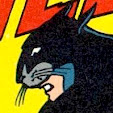 |
| Frank Miller |
- - - - - - - - - -
Miller cover pencils (Klaus Janson inks) = **
"Devils" Miller story pencils (Klaus Janson inks) 22 pages = **
- - - - - - - - - -
Home / Miller / Daredevil / Marvel
ebay >this comic
Miller cover pencils (Klaus Janson inks) = **
"Devils" Miller story pencils (Klaus Janson inks) 22 pages = **
 |
| Frank Miller |
Home / Miller / Daredevil / Marvel
ebay >this comic
(This post has affiliate links which help support this blog)
Daredevil #169 - Frank Miller art & cover
 Reviewed by Ted F
on
9:29 PM
Rating:
Reviewed by Ted F
on
9:29 PM
Rating:
 Reviewed by Ted F
on
9:29 PM
Rating:
Reviewed by Ted F
on
9:29 PM
Rating:


2 comments:
I'm going to take a dissenting opinion on this one. Sure the artwork is a bit looser- this may be because he only recently took over writing duties on the book. In terms of visual storytelling this issue was a career breakthrough. Miller is freed from the flashback devises he used in the previous issue and he delivers some terrific moment-to-moment sequences (including the page you included). Most of the story takes place at night and Miller adds so many nice film noir touches. The cover is classic- Bullseye is now the crazed killer we know rather than the weird hired assassin he was before.
As great as Millers DAREDEVIL is (both the McKenzie-scripted issues from 158-167, as well as the Miller-scripted issues from 168-191) I've consistently been disappointed with the work that came after it over the last 20 or so years.
In some ways I like the McKenzie-scripted issues better, mostly single-issue stories, and nive human dramas. There was a noticeable change from 168-up, and I thinkeditor Dennis O'Neil might be the uncredited co-plotter for much of that latter half.
RONIN was interesting, but overly violent, and too derivative of Kojima and Moebius.
BATMAN YEAR ONE and DARK KNIGHT RETURNS were Miller's last great work, for my money.
This story (issue 169) and issue 191 got inside the head of Bullseye and DD in very interesting ways, defining both the similarities and differences between them.
Post a Comment